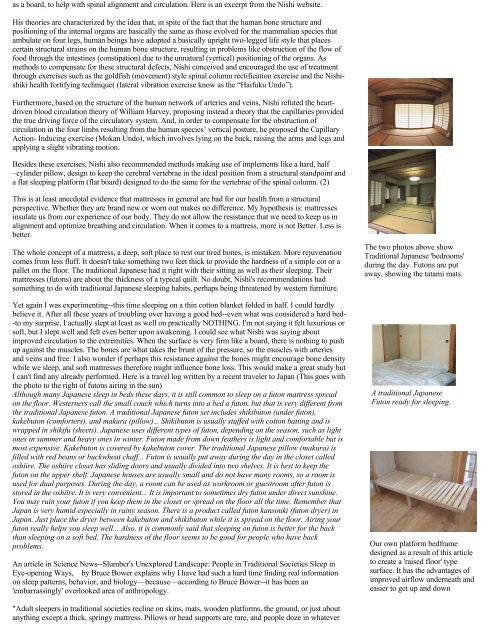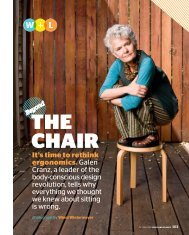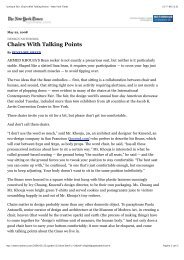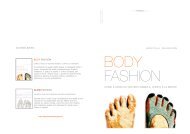sleep ergonomics - Body Conscious Design
sleep ergonomics - Body Conscious Design
sleep ergonomics - Body Conscious Design
You also want an ePaper? Increase the reach of your titles
YUMPU automatically turns print PDFs into web optimized ePapers that Google loves.
as a board, to help with spinal alignment and circulation. Here is an excerpt from the Nishi website.<br />
His theories are characterized by the idea that, in spite of the fact that the human bone structure and<br />
positioning of the internal organs are basically the same as those evolved for the mammalian species that<br />
ambulate on four legs, human beings have adopted a basically upright two-legged life style that places<br />
certain structural strains on the human bone structure, resulting in problems like obstruction of the flow of<br />
food through the intestines (constipation) due to the unnatural (vertical) positioning of the organs. As<br />
methods to compensate for these structural defects, Nishi conceived and encouraged the use of treatment<br />
through exercises such as the goldfish (movement) style spinal column rectification exercise and the Nishishiki<br />
health fortifying technique( (lateral vibration exercise know as the “Haifuku Undo”).<br />
Furthermore, based on the structure of the human network of arteries and veins, Nishi refuted the heartdriven<br />
blood circulation theory of William Harvey, proposing instead a theory that the capillaries provided<br />
the true driving force of the circulatory system. And, in order to compensate for the obstruction of<br />
circulation in the four limbs resulting from the human species’ vertical posture, he proposed the Capillary<br />
Action- Inducing exercise (Mokan Undo), which involves lying on the back, raising the arms and legs and<br />
applying a slight vibrating motion.<br />
Besides these exercises, Nishi also recommended methods making use of implements like a hard, half<br />
–cylinder pillow, design to keep the cerebral vertebrae in the ideal position from a structural standpoint and<br />
a flat <strong>sleep</strong>ing platform (flat board) designed to do the same for the vertebrae of the spinal column. (2)<br />
This is at least anecdotal evidence that mattresses in general are bad for our health from a structural<br />
perspective. Whether they are brand new or worn out makes no difference. My hypothesis is: mattresses<br />
insulate us from our experience of our body. They do not allow the resistance that we need to keep us in<br />
alignment and optimize breathing and circulation. When it comes to a mattress, more is not Better. Less is<br />
better.<br />
The whole concept of a mattress, a deep, soft place to rest our tired bones, is mistaken. More rejuvenation<br />
comes from less fluff. It doesn't take something two feet thick to provide the hardness of a simple cot or a<br />
pallet on the floor. The traditional Japanese had it right with their sitting as well as their <strong>sleep</strong>ing. Their<br />
mattresses (futons) are about the thickness of a typical quilt. No doubt, Nishi's recommendations had<br />
something to do with traditional Japanese <strong>sleep</strong>ing habits, perhaps being threatened by western furniture.<br />
Yet again I was experimenting--this time <strong>sleep</strong>ing on a thin cotton blanket folded in half. I could hardly<br />
believe it. After all these years of troubling over having a good bed--even what was considered a hard bed-<br />
-to my surprise, I actually slept at least as well on practically NOTHING. I'm not saying it felt luxurious or<br />
soft, but I slept well and felt even better upon awakening. I could see what Nishi was saying about<br />
improved circulation to the extremities. When the surface is very firm like a board, there is nothing to push<br />
up against the muscles. The bones are what takes the brunt of the pressure, so the muscles with arteries<br />
and veins and free. I also wonder if perhaps this resistance against the bones might encourage bone density<br />
while we <strong>sleep</strong>, and soft mattresses therefore might influence bone loss. This would make a great study but<br />
I can't find any already performed. Here is a travel log written by a recent traveler to Japan (This goes with<br />
the photo to the right of futons airing in the sun)<br />
Although many Japanese <strong>sleep</strong> in beds these days, it is still common to <strong>sleep</strong> on a futon mattress spread<br />
on the floor. Westerners call the small couch which turns into a bed a futon, but that is very different from<br />
the traditional Japanese futon. A traditional Japanese futon set includes shikibuton (under futon),<br />
kakebuton (comforters), and makura (pillow)... Shikibuton is usually stuffed with cotton batting and is<br />
wrapped in shikifu (sheets). Japanese uses different types of futon, depending on the season, such as light<br />
ones in summer and heavy ones in winter. Futon made from down feathers is light and comfortable but is<br />
most expensive. Kakebuton is covered by kakebuton cover. The traditional Japanese pillow (makura) is<br />
filled with red beans or buckwheat chaff... Futon is usually put away during the day in the closet called<br />
oshiire. The oshiire closet has sliding doors and usually divided into two shelves. It is best to keep the<br />
futon on the upper shelf. Japanese houses are usually small and do not have many rooms, so a room is<br />
used for dual purposes. During the day, a room can be used as workroom or guestroom after futon is<br />
stored in the oshiire. It is very convenient... It is important to sometimes dry futon under direct sunshine.<br />
You may ruin your futon if you keep them in the closet or spread on the floor all the time. Remember that<br />
Japan is very humid especially in rainy season. There is a product called futon kansouki (futon dryer) in<br />
Japan. Just place the dryer between kakebuton and shikibuton while it is spread on the floor. Airing your<br />
futon really helps you <strong>sleep</strong> well... Also, it is commonly said that <strong>sleep</strong>ing on futon is better for the back<br />
than <strong>sleep</strong>ing on a soft bed. The hardness of the floor seems to be good for people who have back<br />
problems.<br />
An article in Science News--Slumber's Unexplored Landscape: People in Traditional Societies Sleep in<br />
Eye-opening Ways, by Bruce Bower explains why I have had such a hard time finding real information<br />
on <strong>sleep</strong> patterns, behavior, and biology—because—according to Bruce Bower--it has been an<br />
'embarrassingly' overlooked area of anthropology.<br />
"Adult <strong>sleep</strong>ers in traditional societies recline on skins, mats, wooden platforms, the ground, or just about<br />
anything except a thick, springy mattress. Pillows or head supports are rare, and people doze in whatever<br />
The two photos above show<br />
Traditional Japanese 'bedrooms'<br />
during the day. Futons are put<br />
away, showing the tatami mats.<br />
A traditional Japanese<br />
Futon ready for <strong>sleep</strong>ing.<br />
Our own platform bedframe<br />
designed as a result of this article<br />
to create a 'raised floor' type<br />
surface. It has the advantages of<br />
improved airflow underneath and<br />
easier to get up and down






